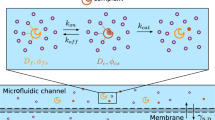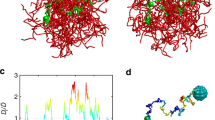Abstract
In this paper the nature and validity of the mathematical formulation of Michaelis–Menten-type kinetics for enzyme-catalysed biochemical reactions is studied. Previous work has in the main concentrated on isolated, spatially uniform (well-mixed) reactions. The effects of substrate input and diffusion on this formulation, in particular, on the nature and validity of the quasi-steady-state-assumption for diffusion-driven fronts are investigated. It is shown that, provided the Michaelis–Menten constant K M is sufficiently large, an appropriate quasi-steady-state assumption is valid at all points in space and for all times other than in a region that closely tracks the front itself. Moreover, it is shown that this region shrinks with time.
Similar content being viewed by others
References
Michaelis L, Menten ML (1913) Die kinetik der invertinwirkung. Biochem Z 49:333–369
Segel LA (1988) On the validity of the steady state assumption of enzyme kinetics. Bull Math Biol 50:579–593
Segel LA, Slemrod M (1989) The quasi-steady-state assumption: a case study in perturbation. SIAM Review 31:446–477
Stryer L (1995) Biochemistry. W. H. Freeman and Company, New York
Battelli F, Lazzari C (1986) Singular perturbation theory for open enzyme reaction networks. IMA J Math Appl Med Biol 3(1):41–51
Palson BO, Lightfoot EN (1984) Mathematical modelling of dynamics and control in metabolic networks I On Michaelis–Menten kinetics. J Theor Biol 111(2):273–302
Schauer M, Heinrich R (1979) Analysis of quasi-steady-sate approximation for an enzymatic one-substrate reaction. J Theor Biol 79:425–442
Stoleriu I, Davidson FA, Liu JL (2002) Asymptotic approximations for Michaelis–Menten type kinetics for enzyme- catalysed reactions with constant input. Applied Analysis Report 021, University of Dundee
Stoleriu I, Davidson FA, Liu JL (2004) Quasi-steady state assumptions for non-isolated enzyme-catalyzed reactions. J Math Biol 48:82–104
Stoleriu I, Davidson FA, Liu JL (2005) Effects of periodic input on the quasi-steady state assumptions for enzyme- catalysed reactions. J Math Biol 50:115–132
Maini PK, Burke MA, Murray JD (1991) On the quasi-steady state assumption applied to Michaelis–Menten and suicide substrate reactions with diffusion. Phil Trans Roy Soc Lond A 337:299–306
Zhou H-X (1997) Theory and simulation of the influence of diffusion in enzyme-catalysed reactions. J Phys Chem B 101:6642–6651
Merkin JH, Sleeman BD (2005) On the spread of morphogens. J Math Biol 51:1–17
Morton KW, Mayers DF (2005) Numerical solution of partial differential equations. Cambridge University Press, Cambridge
Polyanin AD (2002) Handbook of linear partial differential equations for engineers and scientists. Chapman & Hall, New York
Pao CV (1992) Nonlinear parabolic and elliptic equations. Plenum Press, New York
Author information
Authors and Affiliations
Corresponding author
Rights and permissions
About this article
Cite this article
Boswell, G.P., Davidson, F.A. Diffusion fronts in enzyme-catalysed reactions. J Eng Math 59, 157–169 (2007). https://doi.org/10.1007/s10665-007-9142-x
Received:
Accepted:
Published:
Issue Date:
DOI: https://doi.org/10.1007/s10665-007-9142-x




